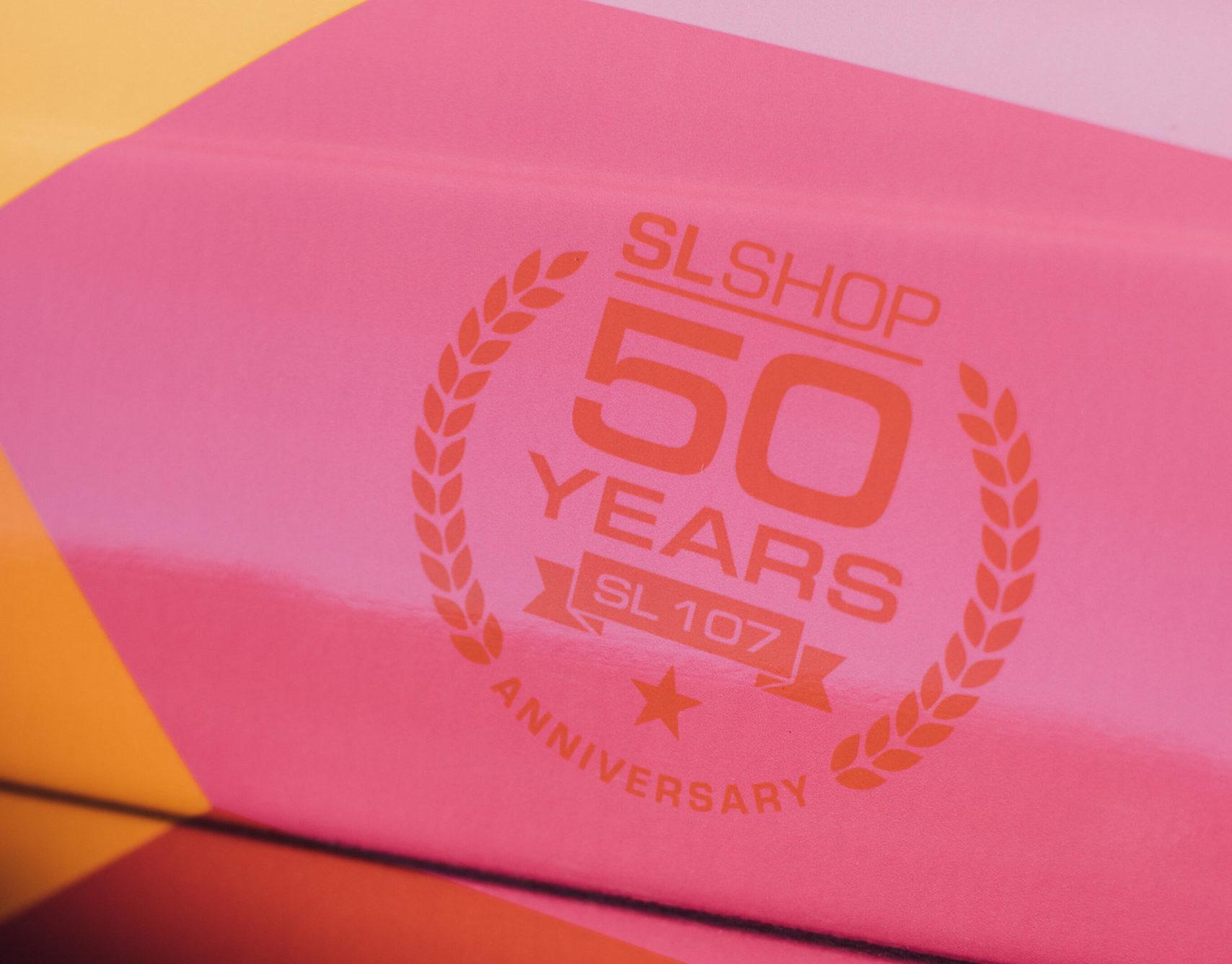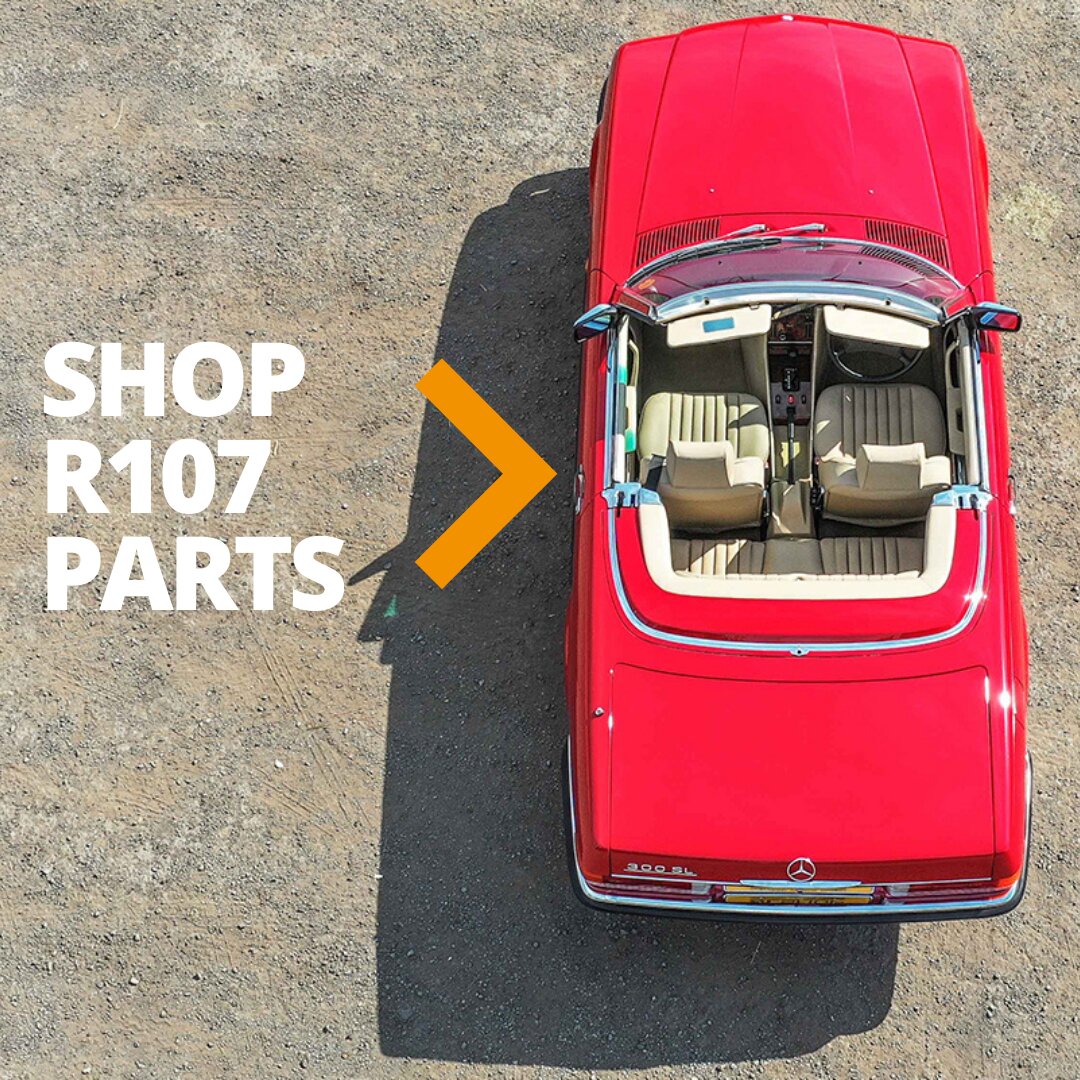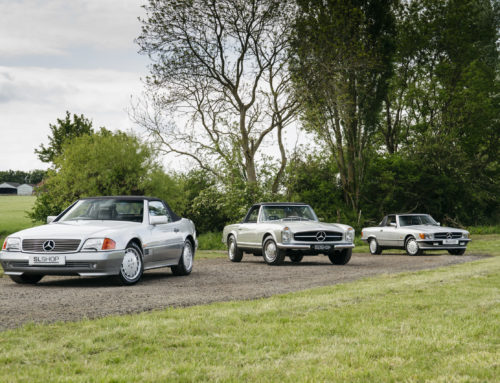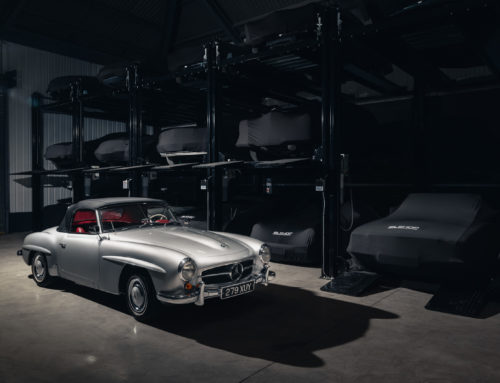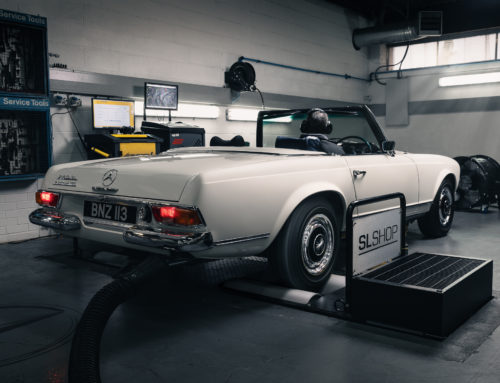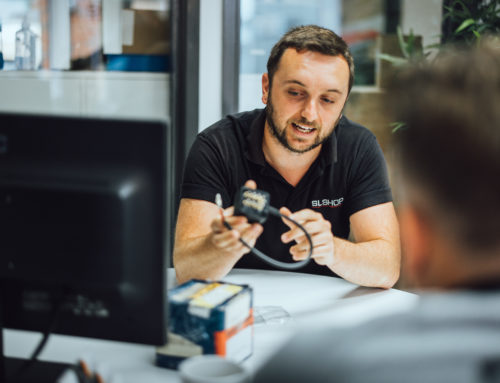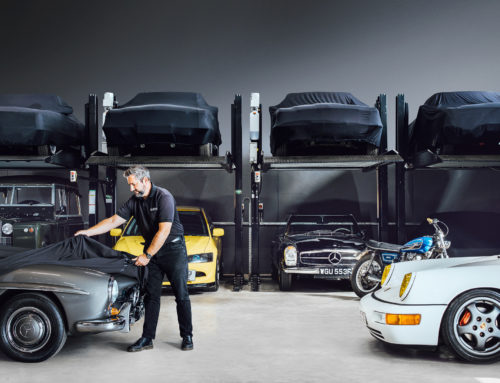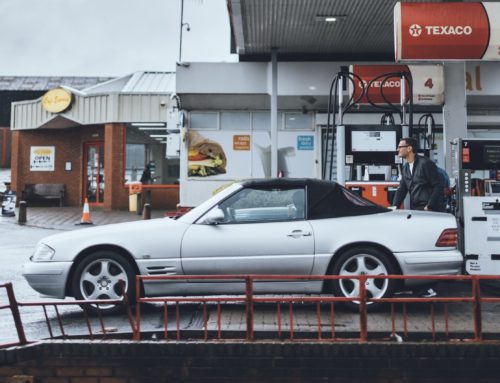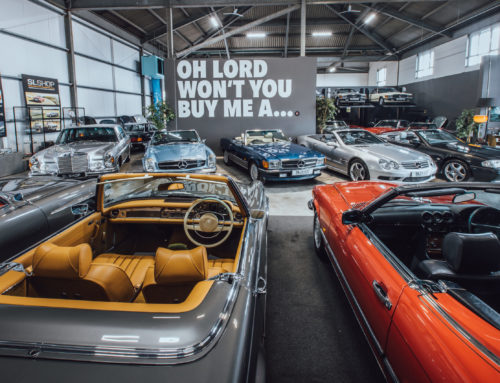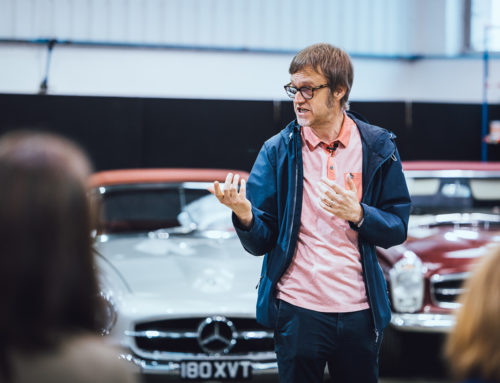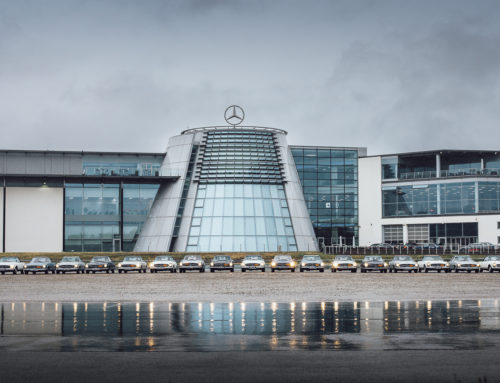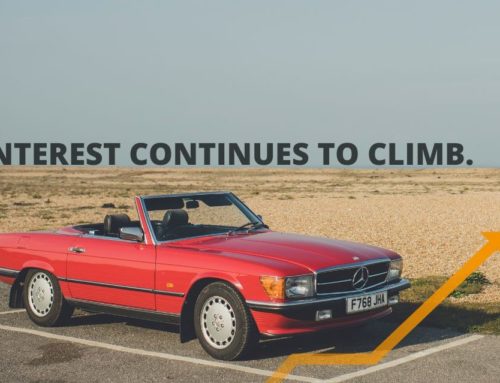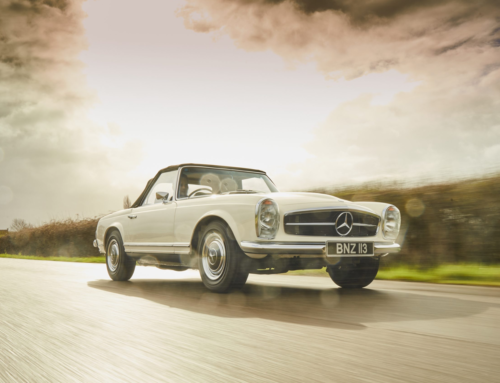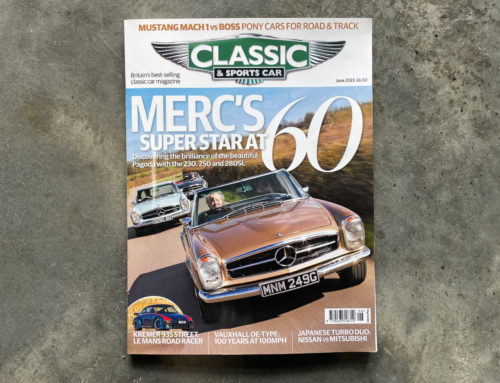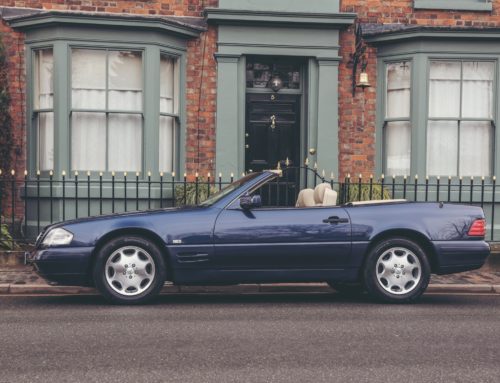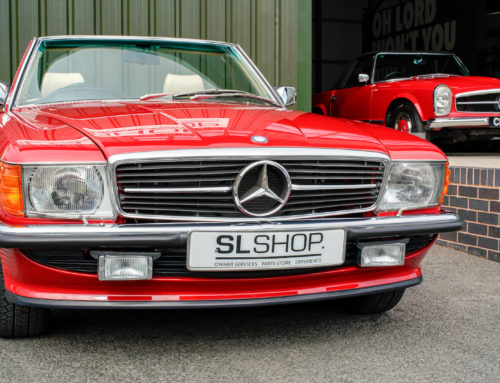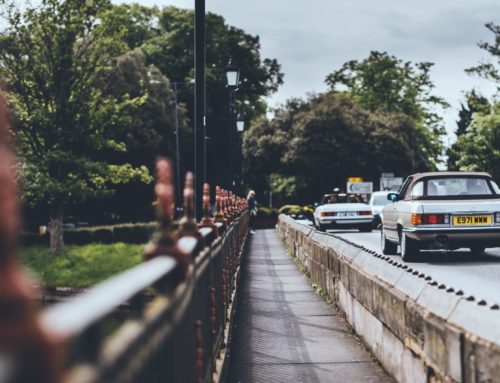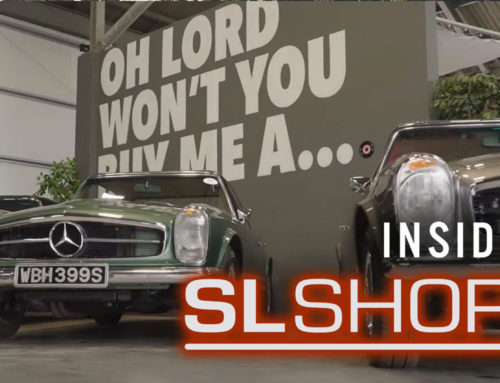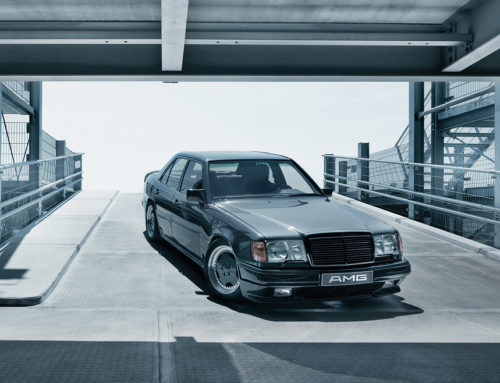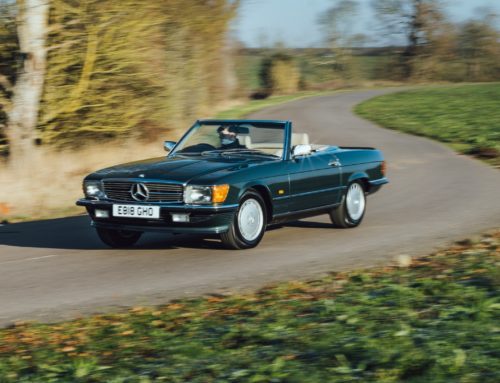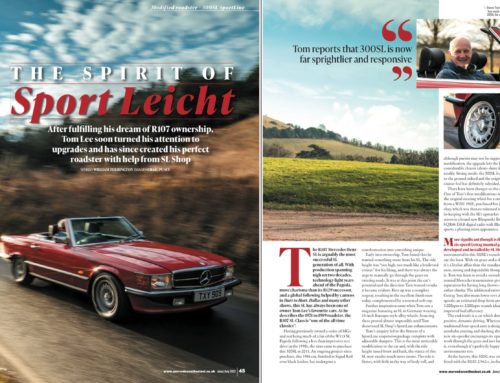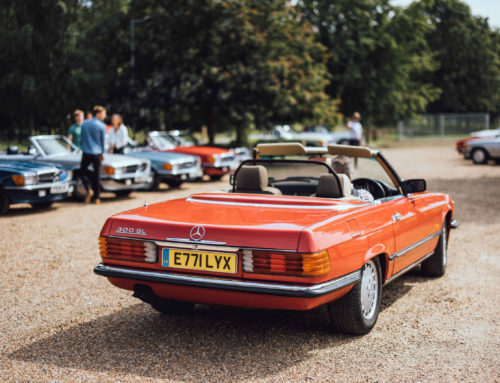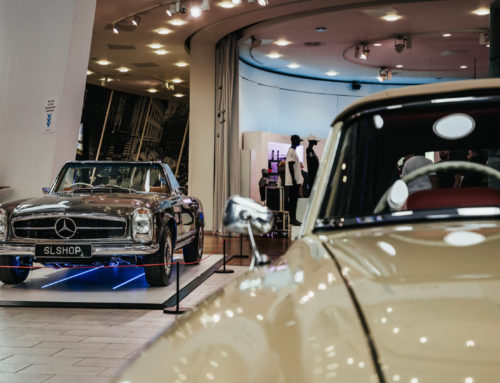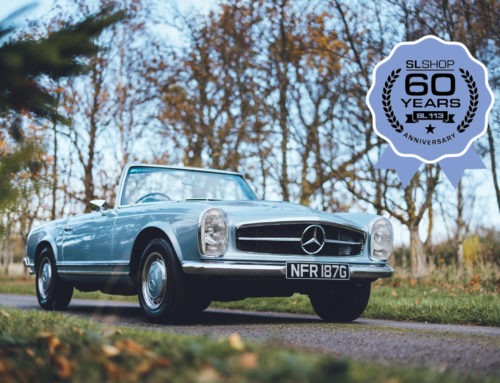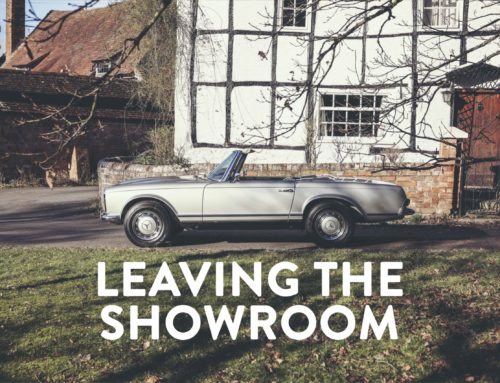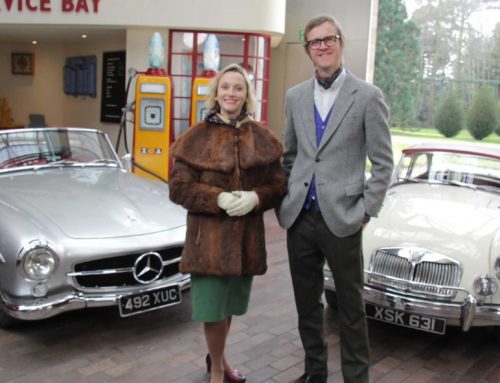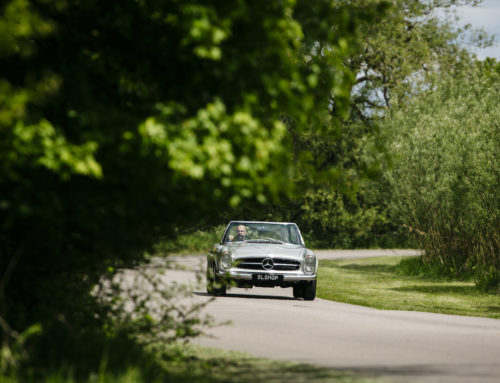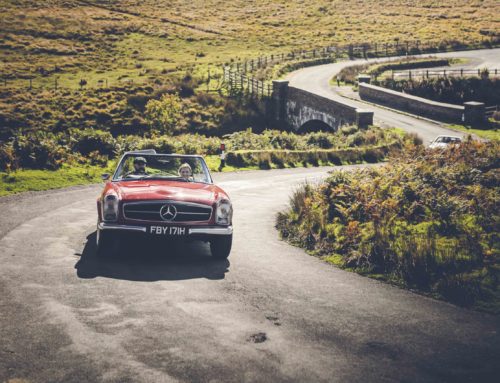Monday 26th July, 2021
A special Anniversary
Five decades ago, the arrival of one of the most important models in Mercedes-Benz history changed the luxury sports car game almost overnight. To pay homage, we dig deep into the history of the Mercedes SL R107 to reveal what made it so great.
There’s no more emblematic machine of the 1980s than the third-generation Mercedes-Benz SL. The R107, to give it its factory designation, perfectly encapsulates that pivotal decade’s aspiration for power, luxury and style. At its peak, the 560/500SL was the chariot of choice for every thrusting go-getter on Wall Street or Canary Wharf. Though there were few who could have predicted such a role for the marque when it was originally conceived.
The American dream
By the 1960s, car makers – especially in the US – were facing a new set of challenges from newly woke consumers. Vehicle safety was placed much higher up the agenda than it ever had been before; thanks largely to Ralph Nader’s paradigm-shifting damnation of the Chevrolet Corvair. Nader’s best-selling Unsafe at Any Speed starkly highlighted the flaws in the American motor industry and brought its reluctance to deal with safety and emissions to the car-buying public’s attention.
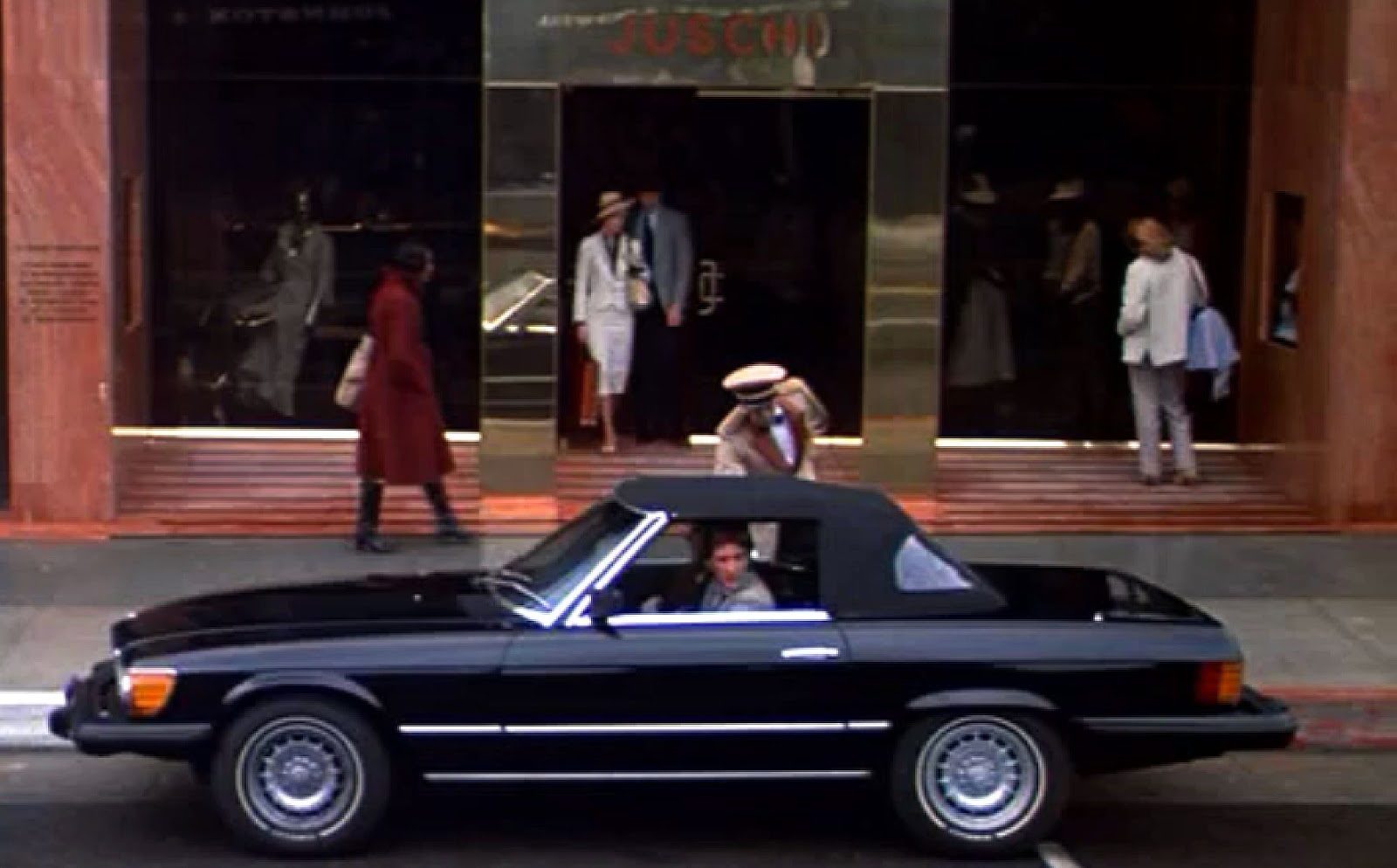
American dollars have always been vital for European sports car makers – Mercedes-Benz was no different. When it looked as though the US (California in particular) might ban open-top cars altogether, the suits in Stuttgart were rightly worried. Mercedes-Benz was selling a significant percentage of its then current W113 ‘Pagoda’ SL to wealthy American customers. The W113 began the SL car’s shift from outright sports car to luxury GT and this changing character was proving popular. Its replacement would need to capitalise on this sales growth, while also improving its predecessor’s in-built safety. No easy task under normal circumstances, yet Mercedes-Benz weren’t even sure if the new model could go on sale in its most lucrative market.
The problem of potential American legislation wasn’t going away and would culminate in an intense battle of wills in the boardrooms of Stuttgart on the 18th of June, 1968. A conservative board of directors wanted to produce a new sports car with a fixed or Targa roof arrangement. This was deemed the only way to future-proof the model against punitive roll-over legislation. Though eventually – after much cajoling by then head of R&D Hans Scherenberg – an open convertible with a detachable hard-top won the day. The proviso was that this convertible would need to be safer than any built to date.
In a further move by Mercedes-Benz to hedge its bets, Karl Wilfert’s design for a coupe version of the Mercedes SL R107 was fast-tracked to production. Then head of body design at the Sindelfingen plant just outside Stuttgart, Wilfert took it upon himself to mock-up a four-seater coupe, which offered greater comfort and space than the convertible Mercedes SL R107. With a few revisions, the C107 would be launched just six months after its open-top sibling.
New standards for safety
The SL car’s class-leading passive safety – a new concept at the time – centred on several key features. The first was mixed-metal thickness in its construction. This meant that the new R107 chassis would deform (or crumple) in a front or rear impact in a predictable manner; greatly reducing the forces transferred to its passengers. But perhaps the key R107 innovation was the strength of its windscreen structure. This was made rigid enough to take the weight of the car if it ever rolled over and negated the need for a roll-over bar. This previously unheard-of strength was achieved by bonding the windscreen and heavily reinforcing the A-pillars, which were now 50 percent stronger than those fitted to the W113. The optional hardtop’s rear glass (standard from 1980) was also bonded in place.
Passenger and safety legislator peace of mind was enhanced further still by tucking the fuel tank up into the area between the boot and rear seat. This meant the tank avoided bearing the brunt of any rear-end collisions. The dashboard was foam padded, top and bottom, to protect heads and knees – with its main controls and switches recessed. Much fanfare was also made of the R107’s new ‘safety wheel’. A strong four-spoke design with a large padded central boss, this wheel was an innovation ahead of its time. This was well over a decade before the arrival of the airbag.
Designing a legend
Conceptual body design for the R107 Mercedes two-seater convertible initially passed through the hands of Ferdinand Hellhage and Josef Gallitzendörfer. The latter would go on to be pivotal in the Bruno Sacco era that followed; with much of his work finding its way into the R129 SL. Responsibility for the Mercedes SL R107’s final design however, fell to the M-B styling team at Sindelfingen, led by veteran Mercedes-Benz stylist Friedrich Geiger. This was to be one of the final designs he oversaw before he retired, having worked for the Stuttgart firm since before the war.
The Mercedes SL R107’s shape was always intended to be a definite departure from what had come before. The classically beautiful lines of the W113 – penned by French stylist Paul Bracq – were to make way for more austere, understated and thoroughly modern straight lines. There were curves, but these were subtly executed. The slight plunge of the bonnet and front wings for example or the mildly concave aspect to the boot lid. Fluting to the bottom third and copious amounts of chrome lifted the glamour of what could have been a pretty staid silhouette. Though it was due to this understated styling that the R107 managed to remain contemporary and in production for nearly two decades.
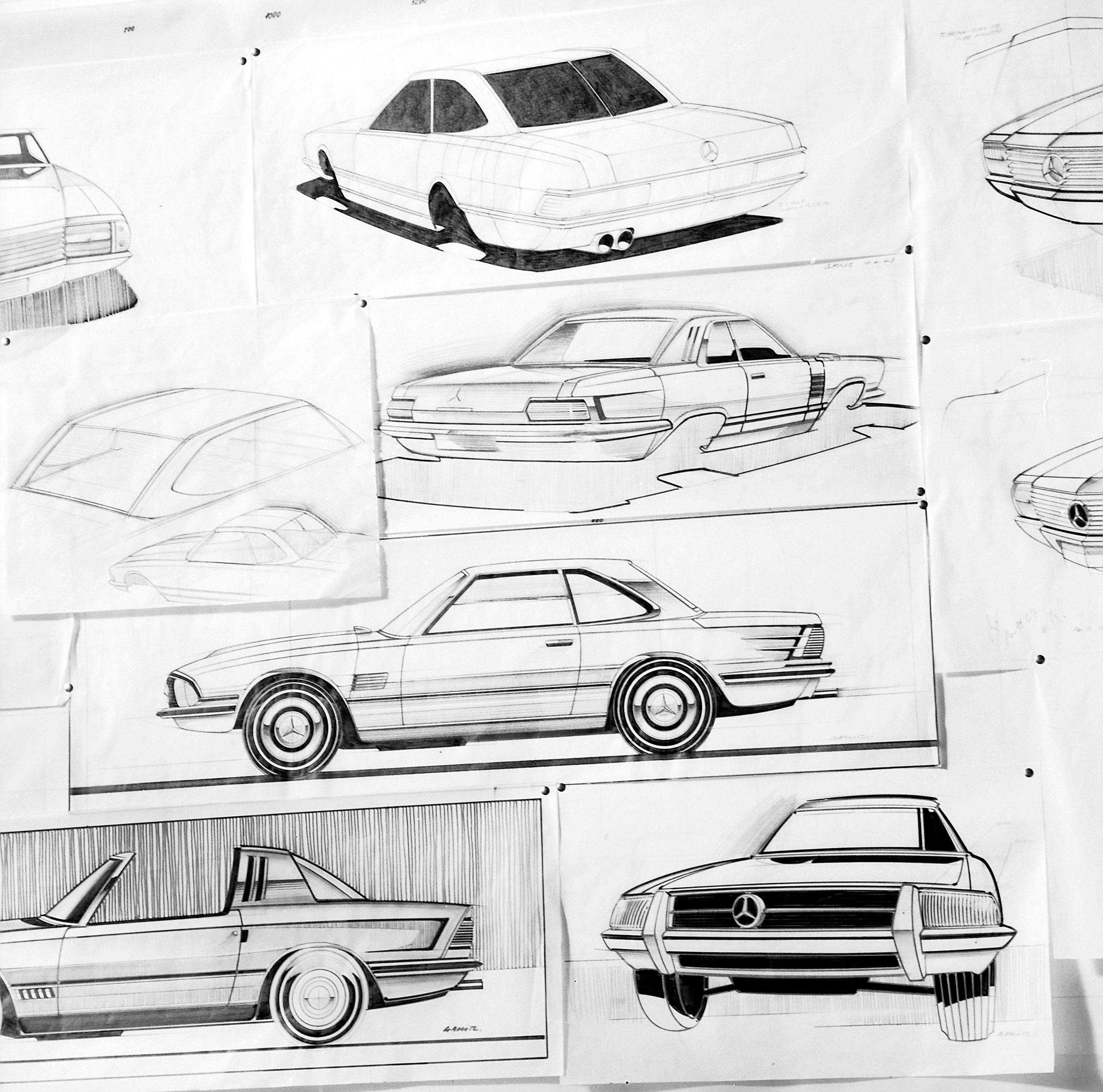
Development and production
The R107 – the first to gain a factory R designation – went on sale in April 1971. Built on a heavily modified W114 saloon platform, this SL was instantly praised for its solid feel. In fact, many an early road tester or customer likened its fit and finish to that of a ‘tank’ or ‘Panzer’. Hardly surprising considering the amount of steel that went into its construction. At 1540kg the ‘Leicht’ part of the original 300SL’s ‘Sportlich-Leicht’ moniker had clearly been deemed less important over the years.
Its construction might have been favourably compared with that of a tank, but the R107 certainly didn’t perform like one. Furthering its appeal to American tastes, it was the first SL to be powered by a V8 engine; in this instance the M116, lifted from the ’69 model 300SEL 3.5. The old hot-rod tactic of taking an engine from a much bigger car and dropping it into a lighter chassis worked wonders. The launch model 197bhp 350SL could top 130mph and get to 60mph in just 8.8 seconds; swift progress for 1971.
October of the same year saw the first of many revised models enter the Mercedes SL R107 range, in this instance a four-seat coupe. Up to the A-post, the SLC was identical to the SL, though from here back, it was very different. The wheelbase grew by 360mm and an extended, near-flat roof housed its back-seat occupants. A steeply-raked rear screen flowed sharply down to a convex boot lid. The overall result was a pleasing pillarless two-door design, though it lacked a little of the instant visual gratification of its open-top progenitor.
The SLC made up for its relative shortfall in elegance with greater structural rigidity and improved aerodynamics. Despite weighing 50kg more than the SL, the SLC could match the top speed of its open-top equivalent. Mercedes-Benz build quality and reliability was put to the ultimate test when the SLC entered the world of international rallying. Against the odds it would prove to be a formidable opponent, especially on endurance events. The 450SLC and later 500SLC would rack up multiple podiums and outright wins in the very toughest South American and African WRC events.
Evolution not revolution
Due to all that scaremongering in the US, most European makers decided to avoid making a true convertible altogether. That left the R107 to effectively corner the market. As a result, there wasn’t a lot of sales pressure to constantly evolve the model, though Mercedes-Benz has never been one to sit on its laurels. Especially when customer demand for this new SL was so high. To intensify the R107’s appeal still further, in the autumn of 1971 American customers got a new, more powerful variant, the 450SL (SLC followed in 1972).
Still powered by an eight-cylinder engine, though in this instance the larger M117 motor, this new top-of-the range SL made 225bhp in European tune – not that we’d see this export-only model in European showrooms until March 1973. This engine would see several displacement and performance hikes and would power top-end R107s until the model went out of production in 1989.
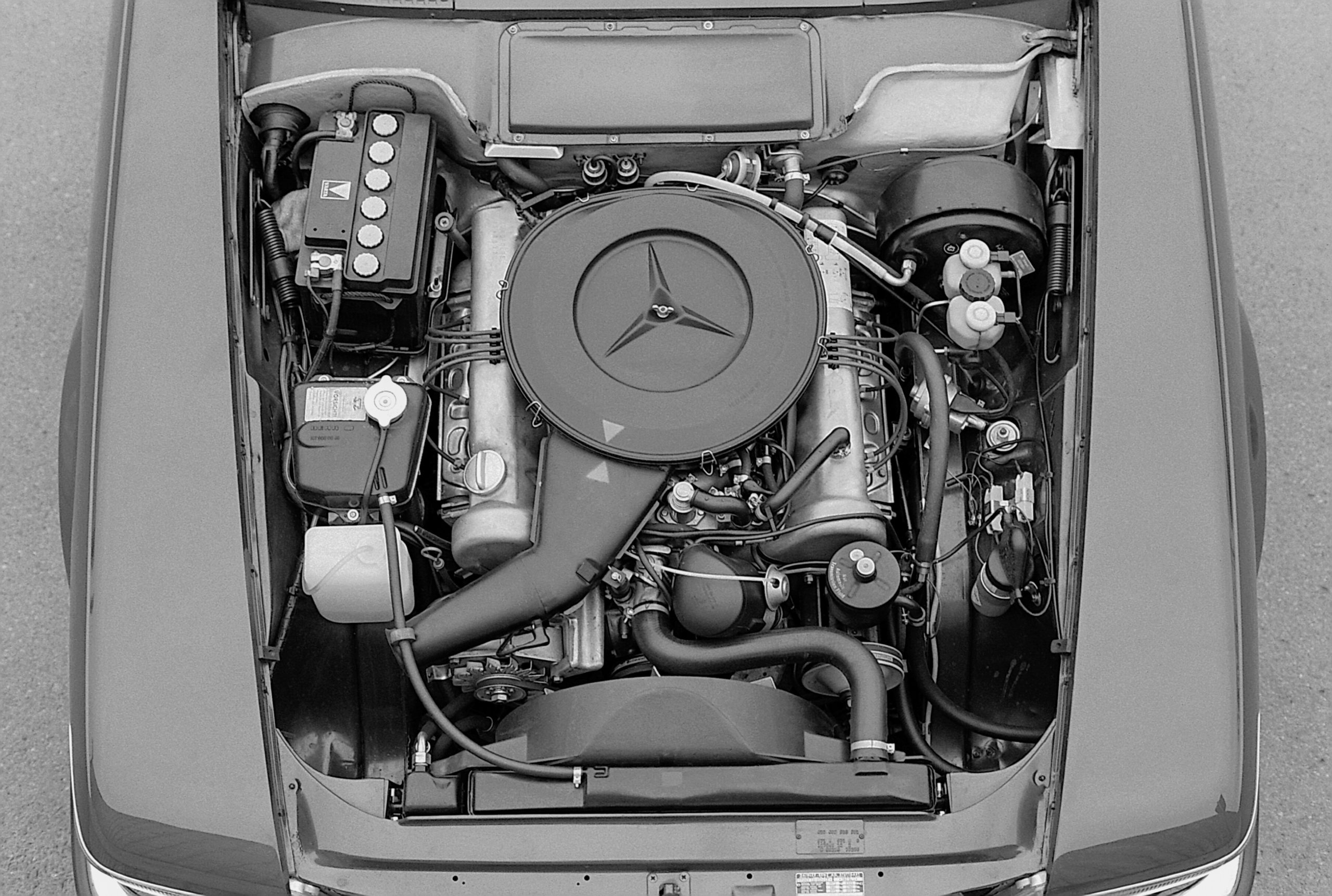
Mercedes-Benz 350 SL (R 107, production period 1971 to 1989). Photo of the engine compartment. (Photo signature in the Mercedes-Benz Classic archive: 71105-9)
If your pockets weren’t quite deep enough to stretch to running a V8 – but you still expected decent performance from your GT – then the R107 had you covered. The six-cylinder 280SL joined the range from 1974 and offered an impressive mix of economy, smooth power delivery and a great soundtrack, plus 187bhp; just 15bhp shy of the 350SL. Though never quite as popular (especially in the States) as the V8 SLs, nevertheless six-cylinder models accounted for just over 20 percent of total sales. The 280SL made enough of a mark by 1986 to gain a replacement in the form of the new M103-powered 300SL, which would last until the end of production.
Changing with the times
As the 1980s dawned, the R107 had already been on sale for nine years, though this product maturity certainly didn’t affect sales. If anything, it improved them. A starring role in hit TV series Dallas also helped to cement the car’s legend. To keep up with technology and safety in the 1980s, Mercedes-Benz threw a raft of upgrades at the SL. Kicking off in 1980 with yet more engines. The 4.5-litre V8 in the 450SL was dropped along with the model to be replaced by a 3.8-litre 215bhp version of the M116 V8 in the newly launched mid-level Mercedes 380SL. Automatic transmissions now had four speeds but more exciting still was the new 5.0-litre range-topping M117 V8 in the 500SL. This 241bhp motor gifted the 500SL with true sports car performance. With 60mph a memory in 7.8 seconds, and capable of topping 140mph, the 500SL had a chance of staying with contemporary exotics like the Ferrari 308.
The 450SLC had now gone but some of the lessons learned from its competition career went on to influence the open-top range. All SLs now had the coupe’s lighter aluminium bonnet as well as its front spoiler. The 500SL went further still with an alloy boot lid topped by a plastic spoiler. The more aggressive appearance and performance of the top-of-the range SL very quickly lifted it to near mythical status. Everyone from Hollywood royalty to actual royalty wanted to be seen driving one. As a result, it played a disproportionately-vital role in the pop culture of the 1980s.
Beyond simply improving performance and visual impact, Mercedes-Benz kept developing the R107’s safety, technology and economy. In late 1981 the ‘Mercedes-Benz Energy Concept’ inspired a major revision to all SL engines. With the aim of reducing emissions and fuel consumption, both V8s got a higher compression ratio, revised camshafts with variable-valve timing, air-bathed injection valves and a new electronic idle-speed controller. The 3.8-litre underwent more fundamental alterations with its bore reduced and stroke increased. Power was slightly reduced for all models but final drive ratios were adjusted, meaning performance was largely unaffected. Also in 1981 after exactly a decade in production, the SLC coupes were replaced by the new W126-based SEC range. From January 1982 ABS braking, safety belt pretensioners and even an airbag, were added to the SL’s options list.
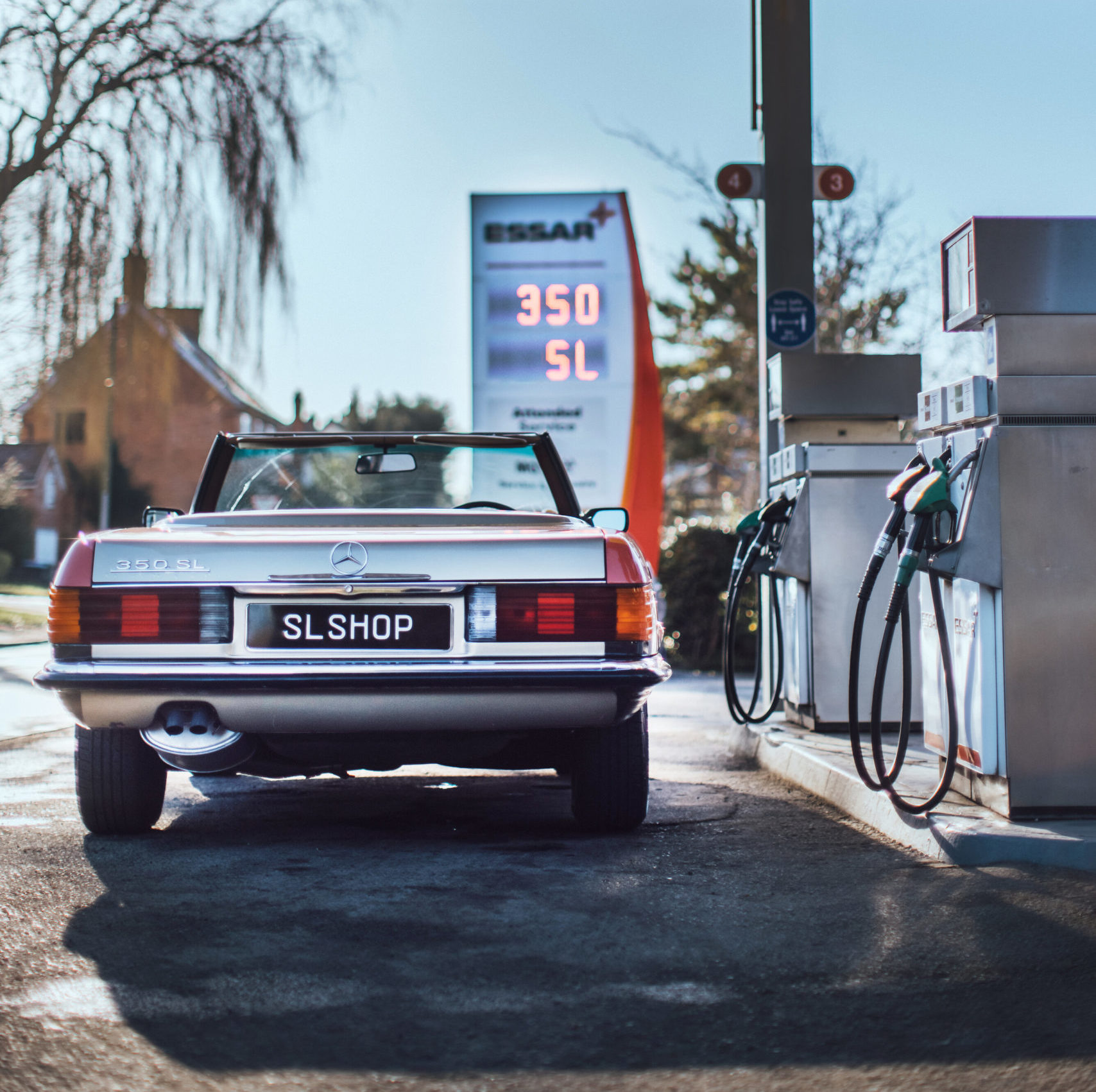
By 1986 the R107 had been on sale for an astonishing 15 years and yet, just three years before it was replaced by the R129, Stuttgart had by no means abandoned its ageing sports car. Quite the opposite, in fact. A subtle yet effective facelift saw all SLs sport a new lower front air dam and 15-inch alloy wheels; very similar to those fitted to the 190E 2.3-16. Catalytic converters became optional and there was another new steering wheel, this one shared with the W126 S-Class. Also coming from a M-B saloon was the new M103 six-cylinder engine. This was lifted from the W124 and found its way into both the SL and 190E. The new 3.0-litre engine replaced the 2.8-litre in the 280SL resurrecting the famous 300SL moniker once more. The US and other selected export markets got a last hurrah, 560SL model with an impressive 5.6-litre version of the M117 V8 engine making an emission-friendly 231bhp. There were significant revisions to the chassis, braking and steering at the same time to keep the SL’s driving dynamics as up-to-date as its safety.
By the time the last Mercedes SL R107 SL left Sindelfingen in August 1989 – more than 18 years since the first 350SL had been made – a total of 237,287 had been produced. A further 62,888 coupe SLCs were also made between ’71 and ’81 bringing total R107 production to an impressive 300,175. The model holds the record for Mercedes-Benz sports car production, one that’s unlikely to ever be beaten.
Beyond the simple facts and figures though, the Mercedes SL R107 was the ideal machine for its era. It not only perfectly encapsulated the Mercedes-Benz principles of elegant design, cutting edge safety and exquisite engineering, but it had just the right dash of opulence and aspiration. It was a package that few contemporary makers could even attempt to rival and it remains one of the most sought-after classic sports cars out there.
Share With Your Fellow Enthusiasts
Monday 26th July, 2021
A special Anniversary
Five decades ago, the arrival of one of the most important models in Mercedes-Benz history changed the luxury sports car game almost overnight. To pay homage, we dig deep into the history of the Mercedes SL R107 to reveal what made it so great.
There’s no more emblematic machine of the 1980s than the third-generation Mercedes-Benz SL. The R107, to give it its factory designation, perfectly encapsulates that pivotal decade’s aspiration for power, luxury and style. At its peak, the 560/500SL was the chariot of choice for every thrusting go-getter on Wall Street or Canary Wharf. Though there were few who could have predicted such a role for the marque when it was originally conceived.
The American dream
By the 1960s, car makers – especially in the US – were facing a new set of challenges from newly woke consumers. Vehicle safety was placed much higher up the agenda than it ever had been before; thanks largely to Ralph Nader’s paradigm-shifting damnation of the Chevrolet Corvair. Nader’s best-selling Unsafe at Any Speed starkly highlighted the flaws in the American motor industry and brought its reluctance to deal with safety and emissions to the car-buying public’s attention.

American dollars have always been vital for European sports car makers – Mercedes-Benz was no different. When it looked as though the US (California in particular) might ban open-top cars altogether, the suits in Stuttgart were rightly worried. Mercedes-Benz was selling a significant percentage of its then current W113 ‘Pagoda’ SL to wealthy American customers. The W113 began the SL car’s shift from outright sports car to luxury GT and this changing character was proving popular. Its replacement would need to capitalise on this sales growth, while also improving its predecessor’s in-built safety. No easy task under normal circumstances, yet Mercedes-Benz weren’t even sure if the new model could go on sale in its most lucrative market.
The problem of potential American legislation wasn’t going away and would culminate in an intense battle of wills in the boardrooms of Stuttgart on the 18th of June, 1968. A conservative board of directors wanted to produce a new sports car with a fixed or Targa roof arrangement. This was deemed the only way to future-proof the model against punitive roll-over legislation. Though eventually – after much cajoling by then head of R&D Hans Scherenberg – an open convertible with a detachable hard-top won the day. The proviso was that this convertible would need to be safer than any built to date.
In a further move by Mercedes-Benz to hedge its bets, Karl Wilfert’s design for a coupe version of the Mercedes SL R107 was fast-tracked to production. Then head of body design at the Sindelfingen plant just outside Stuttgart, Wilfert took it upon himself to mock-up a four-seater coupe, which offered greater comfort and space than the convertible Mercedes SL R107. With a few revisions, the C107 would be launched just six months after its open-top sibling.
New standards for safety
The SL car’s class-leading passive safety – a new concept at the time – centred on several key features. The first was mixed-metal thickness in its construction. This meant that the new R107 chassis would deform (or crumple) in a front or rear impact in a predictable manner; greatly reducing the forces transferred to its passengers. But perhaps the key R107 innovation was the strength of its windscreen structure. This was made rigid enough to take the weight of the car if it ever rolled over and negated the need for a roll-over bar. This previously unheard-of strength was achieved by bonding the windscreen and heavily reinforcing the A-pillars, which were now 50 percent stronger than those fitted to the W113. The optional hardtop’s rear glass (standard from 1980) was also bonded in place.
Passenger and safety legislator peace of mind was enhanced further still by tucking the fuel tank up into the area between the boot and rear seat. This meant the tank avoided bearing the brunt of any rear-end collisions. The dashboard was foam padded, top and bottom, to protect heads and knees – with its main controls and switches recessed. Much fanfare was also made of the R107’s new ‘safety wheel’. A strong four-spoke design with a large padded central boss, this wheel was an innovation ahead of its time. This was well over a decade before the arrival of the airbag.
Designing a legend
Conceptual body design for the R107 Mercedes two-seater convertible initially passed through the hands of Ferdinand Hellhage and Josef Gallitzendörfer. The latter would go on to be pivotal in the Bruno Sacco era that followed; with much of his work finding its way into the R129 SL. Responsibility for the Mercedes SL R107’s final design however, fell to the M-B styling team at Sindelfingen, led by veteran Mercedes-Benz stylist Friedrich Geiger. This was to be one of the final designs he oversaw before he retired, having worked for the Stuttgart firm since before the war.
The Mercedes SL R107’s shape was always intended to be a definite departure from what had come before. The classically beautiful lines of the W113 – penned by French stylist Paul Bracq – were to make way for more austere, understated and thoroughly modern straight lines. There were curves, but these were subtly executed. The slight plunge of the bonnet and front wings for example or the mildly concave aspect to the boot lid. Fluting to the bottom third and copious amounts of chrome lifted the glamour of what could have been a pretty staid silhouette. Though it was due to this understated styling that the R107 managed to remain contemporary and in production for nearly two decades.

Development and production
The R107 – the first to gain a factory R designation – went on sale in April 1971. Built on a heavily modified W114 saloon platform, this SL was instantly praised for its solid feel. In fact, many an early road tester or customer likened its fit and finish to that of a ‘tank’ or ‘Panzer’. Hardly surprising considering the amount of steel that went into its construction. At 1540kg the ‘Leicht’ part of the original 300SL’s ‘Sportlich-Leicht’ moniker had clearly been deemed less important over the years.
Its construction might have been favourably compared with that of a tank, but the R107 certainly didn’t perform like one. Furthering its appeal to American tastes, it was the first SL to be powered by a V8 engine; in this instance the M116, lifted from the ’69 model 300SEL 3.5. The old hot-rod tactic of taking an engine from a much bigger car and dropping it into a lighter chassis worked wonders. The launch model 197bhp 350SL could top 130mph and get to 60mph in just 8.8 seconds; swift progress for 1971.
October of the same year saw the first of many revised models enter the Mercedes SL R107 range, in this instance a four-seat coupe. Up to the A-post, the SLC was identical to the SL, though from here back, it was very different. The wheelbase grew by 360mm and an extended, near-flat roof housed its back-seat occupants. A steeply-raked rear screen flowed sharply down to a convex boot lid. The overall result was a pleasing pillarless two-door design, though it lacked a little of the instant visual gratification of its open-top progenitor.
The SLC made up for its relative shortfall in elegance with greater structural rigidity and improved aerodynamics. Despite weighing 50kg more than the SL, the SLC could match the top speed of its open-top equivalent. Mercedes-Benz build quality and reliability was put to the ultimate test when the SLC entered the world of international rallying. Against the odds it would prove to be a formidable opponent, especially on endurance events. The 450SLC and later 500SLC would rack up multiple podiums and outright wins in the very toughest South American and African WRC events.
Evolution not revolution
Due to all that scaremongering in the US, most European makers decided to avoid making a true convertible altogether. That left the R107 to effectively corner the market. As a result, there wasn’t a lot of sales pressure to constantly evolve the model, though Mercedes-Benz has never been one to sit on its laurels. Especially when customer demand for this new SL was so high. To intensify the R107’s appeal still further, in the autumn of 1971 American customers got a new, more powerful variant, the 450SL (SLC followed in 1972).
Still powered by an eight-cylinder engine, though in this instance the larger M117 motor, this new top-of-the range SL made 225bhp in European tune – not that we’d see this export-only model in European showrooms until March 1973. This engine would see several displacement and performance hikes and would power top-end R107s until the model went out of production in 1989.

Mercedes-Benz 350 SL (R 107, production period 1971 to 1989). Photo of the engine compartment. (Photo signature in the Mercedes-Benz Classic archive: 71105-9)
If your pockets weren’t quite deep enough to stretch to running a V8 – but you still expected decent performance from your GT – then the R107 had you covered. The six-cylinder 280SL joined the range from 1974 and offered an impressive mix of economy, smooth power delivery and a great soundtrack, plus 187bhp; just 15bhp shy of the 350SL. Though never quite as popular (especially in the States) as the V8 SLs, nevertheless six-cylinder models accounted for just over 20 percent of total sales. The 280SL made enough of a mark by 1986 to gain a replacement in the form of the new M103-powered 300SL, which would last until the end of production.
Changing with the times
As the 1980s dawned, the R107 had already been on sale for nine years, though this product maturity certainly didn’t affect sales. If anything, it improved them. A starring role in hit TV series Dallas also helped to cement the car’s legend. To keep up with technology and safety in the 1980s, Mercedes-Benz threw a raft of upgrades at the SL. Kicking off in 1980 with yet more engines. The 4.5-litre V8 in the 450SL was dropped along with the model to be replaced by a 3.8-litre 215bhp version of the M116 V8 in the newly launched mid-level Mercedes 380SL. Automatic transmissions now had four speeds but more exciting still was the new 5.0-litre range-topping M117 V8 in the 500SL. This 241bhp motor gifted the 500SL with true sports car performance. With 60mph a memory in 7.8 seconds, and capable of topping 140mph, the 500SL had a chance of staying with contemporary exotics like the Ferrari 308.
The 450SLC had now gone but some of the lessons learned from its competition career went on to influence the open-top range. All SLs now had the coupe’s lighter aluminium bonnet as well as its front spoiler. The 500SL went further still with an alloy boot lid topped by a plastic spoiler. The more aggressive appearance and performance of the top-of-the range SL very quickly lifted it to near mythical status. Everyone from Hollywood royalty to actual royalty wanted to be seen driving one. As a result, it played a disproportionately-vital role in the pop culture of the 1980s.
Beyond simply improving performance and visual impact, Mercedes-Benz kept developing the R107’s safety, technology and economy. In late 1981 the ‘Mercedes-Benz Energy Concept’ inspired a major revision to all SL engines. With the aim of reducing emissions and fuel consumption, both V8s got a higher compression ratio, revised camshafts with variable-valve timing, air-bathed injection valves and a new electronic idle-speed controller. The 3.8-litre underwent more fundamental alterations with its bore reduced and stroke increased. Power was slightly reduced for all models but final drive ratios were adjusted, meaning performance was largely unaffected. Also in 1981 after exactly a decade in production, the SLC coupes were replaced by the new W126-based SEC range. From January 1982 ABS braking, safety belt pretensioners and even an airbag, were added to the SL’s options list.

By 1986 the R107 had been on sale for an astonishing 15 years and yet, just three years before it was replaced by the R129, Stuttgart had by no means abandoned its ageing sports car. Quite the opposite, in fact. A subtle yet effective facelift saw all SLs sport a new lower front air dam and 15-inch alloy wheels; very similar to those fitted to the 190E 2.3-16. Catalytic converters became optional and there was another new steering wheel, this one shared with the W126 S-Class. Also coming from a M-B saloon was the new M103 six-cylinder engine. This was lifted from the W124 and found its way into both the SL and 190E. The new 3.0-litre engine replaced the 2.8-litre in the 280SL resurrecting the famous 300SL moniker once more. The US and other selected export markets got a last hurrah, 560SL model with an impressive 5.6-litre version of the M117 V8 engine making an emission-friendly 231bhp. There were significant revisions to the chassis, braking and steering at the same time to keep the SL’s driving dynamics as up-to-date as its safety.
By the time the last Mercedes SL R107 SL left Sindelfingen in August 1989 – more than 18 years since the first 350SL had been made – a total of 237,287 had been produced. A further 62,888 coupe SLCs were also made between ’71 and ’81 bringing total R107 production to an impressive 300,175. The model holds the record for Mercedes-Benz sports car production, one that’s unlikely to ever be beaten.
Beyond the simple facts and figures though, the Mercedes SL R107 was the ideal machine for its era. It not only perfectly encapsulated the Mercedes-Benz principles of elegant design, cutting edge safety and exquisite engineering, but it had just the right dash of opulence and aspiration. It was a package that few contemporary makers could even attempt to rival and it remains one of the most sought-after classic sports cars out there.
Share With Your Fellow Enthusiasts
More from Journal
CARE
THE ULTIMATE CERTIFIED SERVICING INVESTMENT PLAN
Your ownership journey matters to us, which is why we have created a simple certified servicing investment plan, tailored to your individual needs and aspirations.
Start investing today and our dedicated CARE team will work with you to increase the value and enjoyment you receive from your vehicle.

STAY IN TUNE WITH SLSHOP MOMENTS
As part of SLSHOP’s community of enthusiasts, you’ll be the first to hear about events and tours, key product offers, exciting stories from owners around the world and of course… our latest additions to the showroom. So, be the first to know and you might just sneak a car on your driveway or take your car’s condition to new heights with our exclusive replacement parts.
Or, visit SLSHOP Journal
